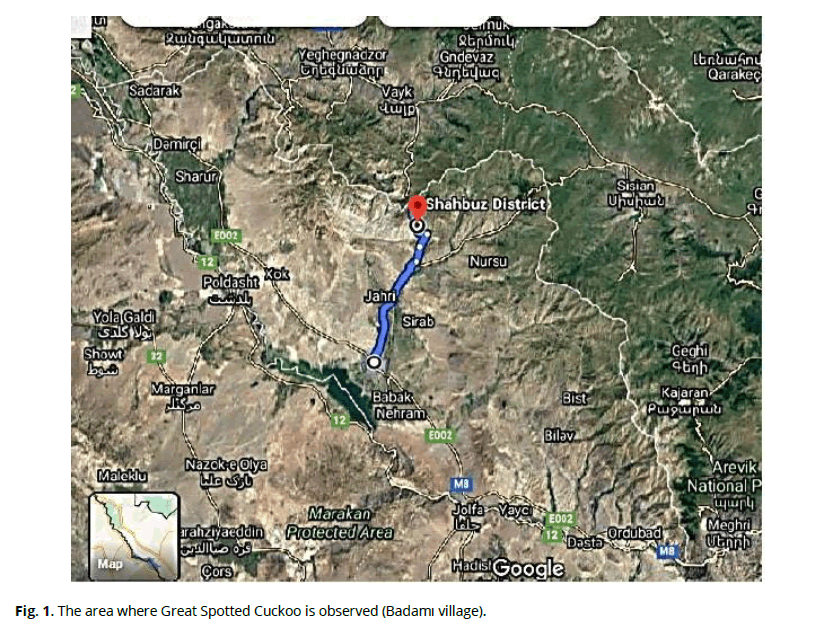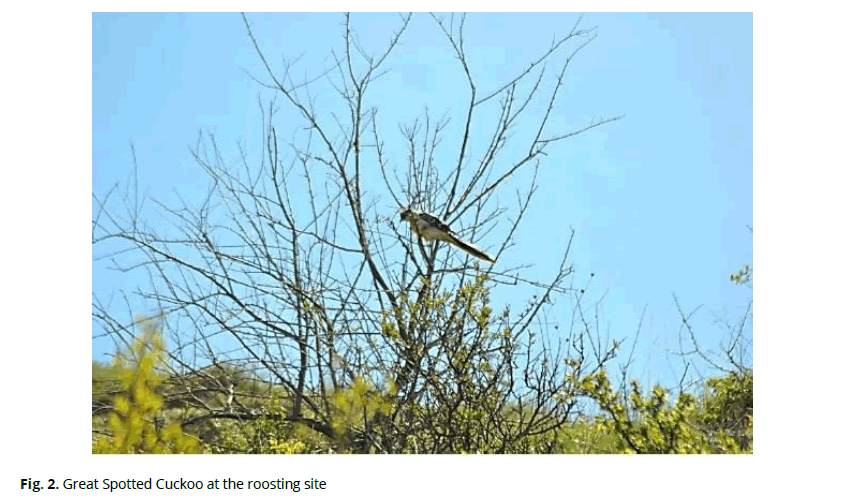Research Article - (2021) Volume 11, Issue 3
Great spotted cuckoo Clamator glandarius, a new species for Azerbaijan and the Nakhchivan Autonomous Republic
A.F. Mammadov1*, A.V. Matsyura2, E.H. Sultanov3 and A. Bayramov1Abstract
Clamator glandarius is reported from the Nakhchivan Autonomous Republic. During the first field trip, one individual was observed, and two individuals during the second trip for species mating were registered.
Keywords
Great spotted cuckoo, Nakhchivan Autonomous Republic, mating, breeding season
Introduction
The Caucasus is one of the biodiversity hotspots, including Georgia, Azerbaijan (Nakhchivan AR), Armenia, and partly northern Iran (Fig. 1). According to Conservation International and WWF, this region is home to many endemic species and is one of the essential hotspot regions in terms of biodiversity (https://www.caucasus-naturefund.org/ecoregion/). The formation of the Caucasus goes back to the Oligocene age (33.7–23.8 Ma); while it was a small continental island in this period, it became a natural barrier by rising at the end of the Pliocene (5–2 Ma) (Demirsoy, 2008). The Caucasus Mountains are divided into two parts: the North Caucasus known as Ciscaucasia in Europe, the North Caucasus as known Ciscaucasia in Europe, the North Caucasus as known Ciscaucasia in Europe, and the South Caucasus (Transcaucasia) in Asia, respectively. The Greater Caucasus mountain range in the north is mainly shared by Russia and Georgia and the northernmost parts of Azerbaijan. The Lesser Caucasus mountain range in the south is occupied by several independent states, namely, Armenia, Azerbaijan (Nakhchivan AR), and Georgia, and extends to the northeastern parts of Turkey and northern Iran.

Figure 1: The area where Great Spotted Cuckoo is observed (Badamı village).
The Nakhchivan Autonomous Republic (NAR) forms a part of Azerbaijan and has a very high biodiversity with diverse landscapes and varied climatic conditions, making it attractive as a research subject. From a geological point of view, the NAR lies at the southeast end of the Lesser Caucasus Mountains, an important part of Western Asia containing many endemics amongst its flora and fauna. The NAR also has representatives of flora and fauna from other biogeography regions. A large part of the NAR is considered a priority corridor of the Caucasus Ecoregional Hotspot. However, scientific data about the NAR bird fauna still reflects the situation at the end of the 19th century (Mammadov, 2006). During the last 15-20 years, there have been noticeable changes in the structure of agriculture, the creation of new wildlife protected areas, and regular conflicts on the border with Armenia (Mammadov, 2010; Patrikeev, 2004). Thus, a current review of bird species in the NAR was required.
Methods
We registered the birds at a distance of 1-2 km with a field telescope and 100-200 m with binocular surveys during our observations. Сamera Eos 400 D and two different camera lens Canon 75-300 mm and 18-55 mm, Tamron 1.4x, teleconverter, 20x60 Swarovski field telescope, and binocular Nikon 10-22x50 had been used. The morphological and ecological features of the species were determined with photographs and Collins Bird Guide (Svensson et al., 2009).
Results
Creat Spotted Cuckoo in Azerbaidjan for the first time was registered on April 26, 2013, near the region Shahbuz district Badamı village of Nahkhchivan AR (39.467286 N, 45.508378E), (Figs. 1-2).

Figure 2: Great Spotted Cuckoo at the roosting site
The second discovery of an adult bird was on April 26, 2018, when it was mated near the village of Kolanı in the Sahbuz district (39.44763N, 45.65250 E, Fig. 3).

Figure 3: The area where Great Spotted Cuckoo was registered (village of Kolanı).
However, there is no information about nesting in the area. The bird was observed for about an hour; before flying away, we heard a twice loud and drawn-out “kiii-ah” sound.
Discussion
Great Spotted Cuckoo Clamator glandarius (Linnaeus, 1758) is widely distributed in tropical Africa, the Middle East, and the Mediterranean part of Europe. In the central part of its range, populations of the crested cuckoo are sedentary, while South African, Middle Eastern, and European populations migrate. It is assumed that all bird populations winter in the African continent. Great Spotted Cuckoo is an obligate nesting parasite. The breeding species of the Great Spotted Cuckoo include mainly corvids, as well as some long-tailed and spray starlings, which nest in hollows, in burrows in sandy cliffs, and in piles of stones (Lamprotornis spp., Onychognathus spp., Spreo bicolor) (Cramp 1985; del Hoyo et al. 1997). Raven guarding birds are represented by blue Cyanopica cyanus and common Pica pica magpies, black Corvus corone, and gray C. cornix crows, sporadically and locally Garrulus glandarius jay, Pyrrhocorax pyrrhocorax bough, Corvus monedula jackdaw, C. monedula common, and Corvus corax bristly black C. rhipidurus.
The breeding season of the Great Spotted Cuckoo in the Mediterranean and Europe is synchronized with the breeding season of the main breeding species (magpie) and is confined to the end of April - the beginning of June. Chicks leave the nest at the end of May, and until they leave for the winter, they can occur up to November (Cramp, 1985; Numerov 1993). In Spain, adult birds leave their breeding grounds in mid-June, while juveniles remain until early August (del Hoyo et al., 1997). Landings of the crested cuckoo are known in most Western European countries, Eastern European countries, and Turkmenistan (Cramp, 1985; Numerov 1993). The species was reported for the Turkey area (Lepage, 2021), while it was not registered for the territory of the Azerbaijan (Clements, 2000; Gill & Donsker. 2019; Lepage, 2007) and Nakhchivan Autonomous Republic before.
Acknowledgments
We want to thank the local authorities of the Ministry of Ecology and Natural Resources of Azerbaijan for their support in monitoring activities.
References
Clements, J.F. (2000). Birds of the World: a Checklist. Cornell University Press.
Cramp, S. (1985). The Birds of the Western Palearctic. Oxford Univ. Press, 4, 1-960.
del Hoyo, J., Elliott, A., Sargatal, J. (1997). Handbook of the Birds of the World. Lynx Editions, 4, 1-679.
Demirsoy, A. (2008). Genel ve Türkiye Zoocoğrafyası "Hayvan Coğrafyası". Meteksan A.Ş. P.K. 105, 06572 Maltepe. Ankara (in Turkish).
Gill, F., Donsker, D. (Eds). (2019). IOC World Bird List (v 9.2). doi:10.14344/IOC.ML.9.2. Available from; http://www.worldbirdnames.org/. Accesed on 30.03.2021.
Klem, D. Jr. (2005). Reviewed Work: The Birds of Azerbaijan by Michael Patrikeev, Geoffrey H. Harper. The Wilson Bulletin, 117 (4). 423-425.
Lepage, D. (2007). Checklist of birds of Azerbaijan. Bird Checklists of the World. Avibase. Available from: https://web.archive.org/web/20070930132907/http://www.bsc-eoc.org/avibase/avibase.jsp?region=az&pg=checklist&list=clements. Accessed on 01.04.2021
Lepage, D. (2021). Checklist of birds of Turkey. Bird Checklists of the World. Avibase. Available from: https://avibase.bsc-eoc.org/checklist.jsp?lang=FR®ion=tr&list=sacc/ Accessed on 01.04.2021.
Mammadov, A.F. (2006). The taxonomic spectrum of Nakhchivan Autonomous Republic avifauna. News of Azerb. Nat. Acad. Sci., Biol. Ser., Baku, Elm 3(4), 85-91 (in Azerb.).
Mammadov, A.F. (2010). Ornithofauna of Araz River along the belt of Nakhchivan Autonomous Republic. News of Azerbajdian. Nakhchivan Academy of Science. Nakhchivan branch, Tusi, 2, 173-179 (in Azerb.).
Naumov, A.D. (1993). Xoxlataya kukuşka. Ptiçı Rossii i sopredelnıx reqionov: Ryakoobraznıe,
Qolubeobraznıe, Kukuşkoobraznıe, Soboobraznıe. Moscow (in Russian).
Patrikeev, M. (2004). Birds of Azerbaijan. Pensoft Series Faunistica. Volume 38. Pensoft Pulishers.
Svensson, L., Mullarney, K., Zetterstrom, D. (2009). The most complete guide to the birds of Britain and Europe. Collins Bird Guide, 2nd edition, London, UK.
Author Info
A.F. Mammadov1*, A.V. Matsyura2, E.H. Sultanov3 and A. Bayramov12Altai State University, 61 Lenin St., Barnaul, Russian Federation
3Azerbaijan Ornithological Society, Baku Engineering University, Baku, Azerbaijan
Citation: Mammadov, A.F., Matsyura, A.V., Sultanov, E.H., Bayramov, A. (2021). Great spotted cuckoo Clamator glandarius, a new species for Azerbaijan and the Nakhchivan Autonomous Republic. Ukrainian Journal of Ecology, 11 (3), 75-78.
Received: 10-Apr-2021 Accepted: 22-May-2021 Published: 31-May-2021, DOI: 10.15421/2021_146
Copyright: This is an open access article distributed under the terms of the Creative Commons Attribution License, which permits unrestricted use, distribution, and reproduction in any medium, provided the original work is properly cited.
